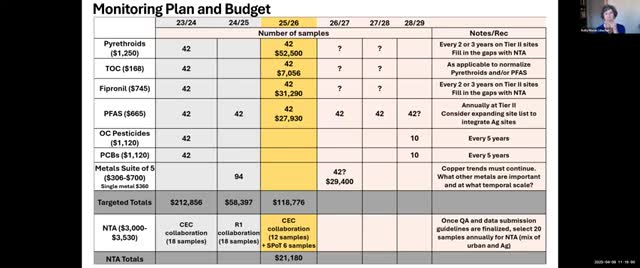State Water Board addresses concerns over lab changes in environmental monitoring program
April 26, 2025 | California Water Quality Monitoring Council, Boards and Commissions, Executive, California
This article was created by AI summarizing key points discussed. AI makes mistakes, so for full details and context, please refer to the video of the full meeting. Please report any errors so we can fix them. Report an error »

In a recent meeting of the California Water Quality Monitoring Council, concerns about data integrity and laboratory consistency took center stage, highlighting the challenges faced in monitoring water quality across the state. As representatives gathered to discuss the 2025 SPoT SRC program, the conversation quickly turned to the implications of using different laboratories for trend analysis, particularly regarding the monitoring of hazardous substances like PCBs and PFAS.
One participant expressed deep apprehension about the reliability of data when switching between labs, recounting past experiences where such changes led to significant misunderstandings about contamination trends. “We thought we had trends on PCBs that we didn't have,” they noted, emphasizing the need for a stable laboratory environment to ensure accurate and consistent data collection. The speaker advocated for a return to a centralized state lab capable of handling all testing, arguing that without this, comparisons of data across years and labs would be fraught with uncertainty.
The discussion also touched on the importance of maintaining the same methodologies in laboratory practices. Participants agreed that while innovation in testing methods is crucial, it must not come at the expense of data consistency. The need for rigorous quality assurance and quality control (QA/QC) measures was underscored, with one member highlighting the ongoing efforts to refine these processes to ensure that future data remains reliable.
As the meeting progressed, the topic of PFAS—a group of chemicals increasingly recognized as environmental hazards—emerged as a critical issue. Participants acknowledged the rapidly evolving science surrounding PFAS and the inadequacy of current testing protocols. One speaker pointed out that while the state has established a targeted list of 40 PFAS compounds for monitoring, the landscape of these chemicals is changing, necessitating a more flexible and comprehensive approach to testing.
The conversation concluded with a commitment to maintaining strong relationships with current laboratories, particularly emphasizing the importance of continuity in personnel and methods. As the council looks ahead to the next five years, the focus remains on building a robust framework for water quality monitoring that can adapt to new challenges while ensuring the integrity of the data collected.
This meeting not only highlighted the complexities of water quality monitoring in California but also underscored the collaborative efforts needed to navigate these challenges effectively. As the state grapples with environmental concerns, the commitment to high-quality data and consistent methodologies will be crucial in safeguarding California's water resources for the future.
One participant expressed deep apprehension about the reliability of data when switching between labs, recounting past experiences where such changes led to significant misunderstandings about contamination trends. “We thought we had trends on PCBs that we didn't have,” they noted, emphasizing the need for a stable laboratory environment to ensure accurate and consistent data collection. The speaker advocated for a return to a centralized state lab capable of handling all testing, arguing that without this, comparisons of data across years and labs would be fraught with uncertainty.
The discussion also touched on the importance of maintaining the same methodologies in laboratory practices. Participants agreed that while innovation in testing methods is crucial, it must not come at the expense of data consistency. The need for rigorous quality assurance and quality control (QA/QC) measures was underscored, with one member highlighting the ongoing efforts to refine these processes to ensure that future data remains reliable.
As the meeting progressed, the topic of PFAS—a group of chemicals increasingly recognized as environmental hazards—emerged as a critical issue. Participants acknowledged the rapidly evolving science surrounding PFAS and the inadequacy of current testing protocols. One speaker pointed out that while the state has established a targeted list of 40 PFAS compounds for monitoring, the landscape of these chemicals is changing, necessitating a more flexible and comprehensive approach to testing.
The conversation concluded with a commitment to maintaining strong relationships with current laboratories, particularly emphasizing the importance of continuity in personnel and methods. As the council looks ahead to the next five years, the focus remains on building a robust framework for water quality monitoring that can adapt to new challenges while ensuring the integrity of the data collected.
This meeting not only highlighted the complexities of water quality monitoring in California but also underscored the collaborative efforts needed to navigate these challenges effectively. As the state grapples with environmental concerns, the commitment to high-quality data and consistent methodologies will be crucial in safeguarding California's water resources for the future.
View full meeting
This article is based on a recent meeting—watch the full video and explore the complete transcript for deeper insights into the discussion.
View full meeting
